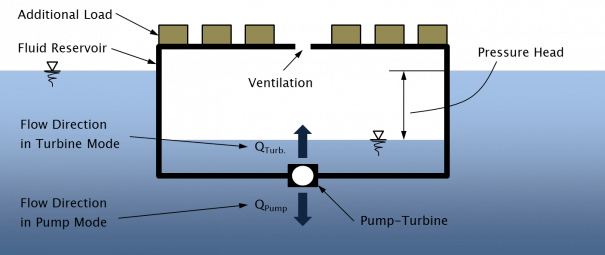Basic Principles of "Buoyant Energy"
The basic principle of Buoyant Energy (buoyant hydraulic energy storage system) is based on the well-established technology behind pumped hydro energy storage plants. The major difference is the arrangement and location of reservoirs at such plants. While conventional pump hydropower storage plants consist of an upper and a lower reservoir, Buoyant Energy uses a smaller reservoir (buoyant platform), located within a larger reservoir (see image below). Water can be moved from one reservoir to the other by means of pumps and turbines.

Buoyant Energy concept (floating pumped energy storage)
The energy is stored solely through the potential energy of the mass of the floating structure. In order to store energy, water from the smaller reservoir is pumped to the larger reservoir (pump mode). As a result, the floating structure that encloses the smaller reservoir rises. In order to release the energy, the structure is lowered and the inflow into the smaller reservoir powers a turbine (turbine mode).
The large reservoir could be any large body of water, like a lake, the sea or even the ocean. One possibility would be the arrangement of the afore mentioned floating structures close to the offshore wind farms in the North Sea, where a large storage capacity is needed, due to the highly irregular energy generation.

Buoyant Energy Animation of the Pump- and Turbine Mode
